Looking for sketchbook cover ideas? Get ready for a wild ride with 23 inspiring designs, from bold collage covers packed with magazine clippings and concert tickets, to splashy watercolor swirls that look like an art party exploded. Some feature doodle explosions, trendy geometric patterns, or moody black and white contrasts. Others rock textures like embroidered fabric or shiny metallic foil. Even minimalist and kraft paper covers get a spot. Curious which one will reveal your next creative spark? Keep going!
Key Takeaways
- Experiment with collage techniques using fabrics, magazine clippings, and personal mementos for dynamic, story-rich sketchbook covers.
- Incorporate watercolor abstracts and mixed media, allowing spontaneous patterns and metallic accents for unique, expressive designs.
- Capture nature themes with bold landscape collages, seasonal elements, or botanical illustrations to bring the outdoors onto your cover.
- Utilize minimalist approaches, such as black and white geometric patterns or hand-lettered typography, for a sophisticated and modern look.
- Personalize with doodle explosions, stickers, and expressive self-portraits, making each sketchbook cover a reflection of your creativity and identity.
Collage-Inspired Mixed Media Cover
Even though a plain old sketchbook cover can get the job done, a collage-inspired mixed media cover is like turning your notebook into a work of art before you even open the first page.
With collage, artists can mix up everything—fabric, magazine clippings, cool old photos, or even hand-painted graphics—layering them until the cover design almost pops out and says, “Pick me!”
The best part about mixed media art is how it lets you break the rules. Bold colors and wild textures? Yes, please! You can even theme your cover around your favorite band, animals, or that magical universe you wish you lived in.
Plus, building a collage is like a fun puzzle, testing your creativity as you plan, arrange, and experiment.
Watercolor Abstract Design
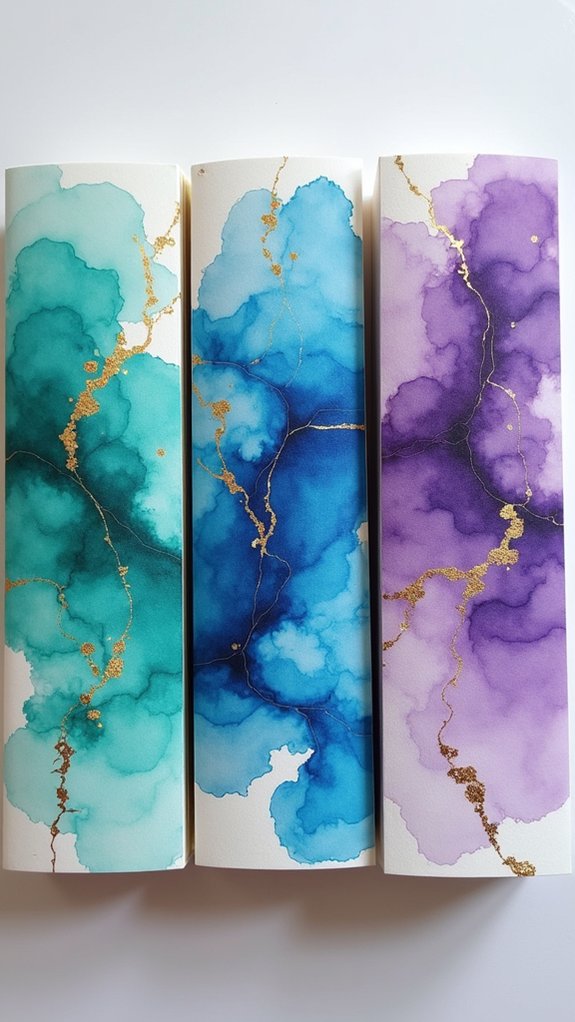
Swirls of watercolor can transform a boring sketchbook cover into pure magic. With watercolor abstract designs, artists get to play with colors that swoosh, blend, and unexpectedly team up—like a wild party on paper.
Wet-on-wet techniques make colors bleed and dance, while wet-on-dry adds sharp, bold edges. It’s all about trusting the flow and letting the happy accidents happen.
Want to really spice up a creative cover? Try throwing in some mixed media elements like metallic ink or gold leaf. That shimmer isn’t just eye candy—it’s a total game-changer.
Experimenting with different watercolor paper can lead to amazing results too. Every brushstroke and splash is unique, turning each sketchbook into a one-of-a-kind masterpiece that feels personal and bold.
Seasonal Festive Theme
Nothing says “personal style” quite like a sketchbook cover dressed up for the holidays. Imagine opening your sketchbook to see frosty winter scenes, bright jack-o’-lanterns, or a sprig of mistletoe dancing across the cover—suddenly, it feels like the season is smiling just for you!
Seasonal themes not only make fun sketchbook cover ideas, but they also let artists show off their mood and creativity year-round. Artists love using mixed media techniques, like blending watercolor snowflakes with bold acrylic pumpkins, to make their covers pop.
Workshop events—think “Starry Christmas Night”—encourage everyone to get crafty with holiday motifs and festive colors, making each book a one-of-a-kind celebration. It’s like giving your art a party invitation every time you pick it up!
Minimalist Black and White Cover
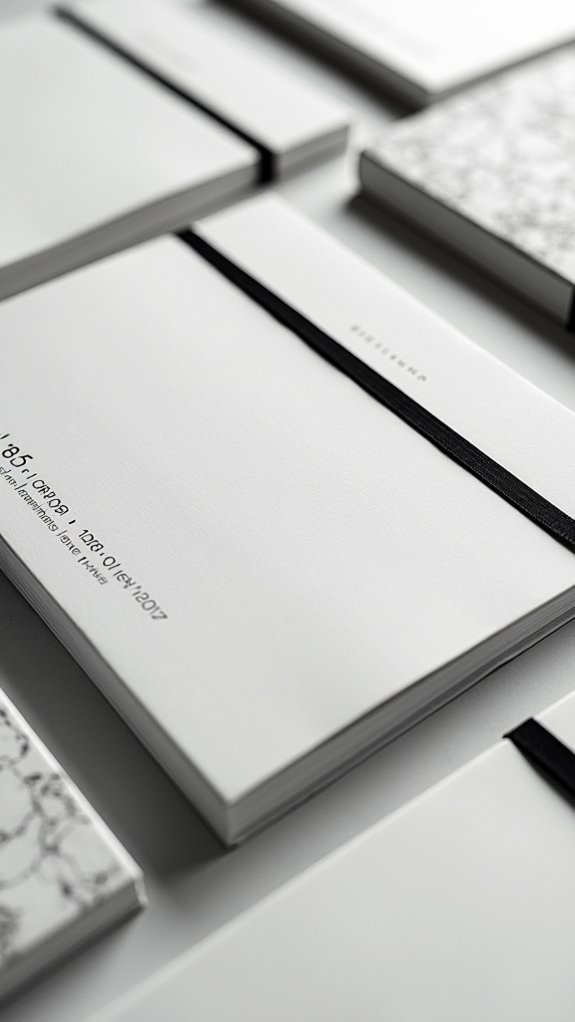
While some covers go wild with color and pattern, a minimalist black and white sketchbook cover makes a totally different statement—it’s bold, crisp, and actually kind of dramatic.
These covers use Graphic Design tricks like strong contrasts, geometric shapes, and clean lines, creating book cover ideas that feel modern and almost futuristic. Even with only two colors, minimalist black and white covers still stand out on a shelf.
Add some cool hand-lettering or your favorite word in clever typography and wham—instant personality, minus any messiness. If you want some extra flair, a textured material in black and white, like canvas or linen, feels fancy without being fussy.
Plus, the simple style gives artists room to personalize covers however they want.
Embroidered Textile Cover
Minimalist black and white is cool, but sometimes a sketchbook cover begs for something with way more personality—think soft threads, pops of color, and maybe even a little sparkle.
That’s where embroidered textile covers shine brightest. These covers aren’t just for looks—they have an artistic dimension that’s all about texture and feeling.
Imagine running your fingers over a bold, hand-stitched mountain or a field of crazy-bright flowers. It’s not just fabric; it’s your vibe, stitched on display!
Artists can use different fabrics and techniques to make each cover a unique cover design, from shiny threads that catch the light to chunky stitches with tons of character.
Bonus: these covers are tough, so your best ideas are protected and looking extra fancy.
Hand-Lettered Typography Art

If a sketchbook cover is a blank stage, then hand-lettered typography art is the starring act that demands everyone’s attention.
There’s something epic about design using swooping letters, quirky fonts, and splashes of bright color that shout, “Look at me!” on a sketch book cover. Artists use hand-lettered typography to give their covers personality and mood.
Whether it’s brush lettering, wild calligraphy, or even goofy doodle letters, the style shows off pure creativity. It also feels good—drawing funny fonts is surprisingly calm, way better than fidget spinners!
Here are four reasons to try hand-lettered typography next time:
- It makes your sketch book cover one-of-a-kind.
- You can match the theme or mood.
- It’s relaxing and fun.
- Tools like gel pens and watercolors make colors pop!
Photo Montage Front Page
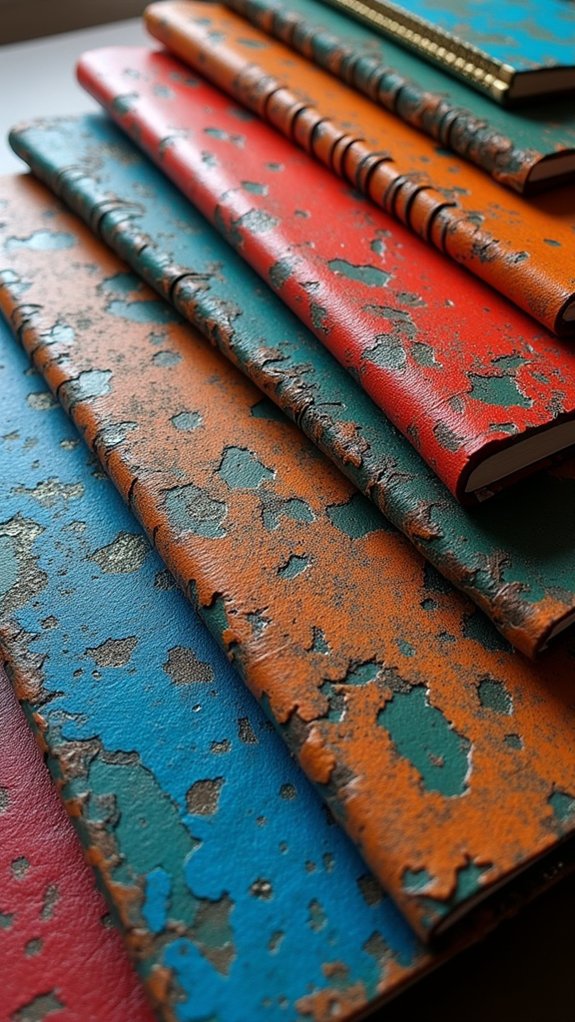
A pair of scissors, a stack of photos, and a splash of wild imagination—suddenly, a plain sketchbook cover transforms into a photo montage masterpiece.
This style is perfect for anyone craving cover ideas aesthetic that pack a visual punch and tell a story before you even flip the first page.
Imagine layering favorite snapshots, magazine clippings, or found treasures, then mixing them with paint splatters or lettering using mixed media techniques.
Want your cover to really pop? Play with bold colors, unexpected textures, or even seasonal themes—like that epic snowball fight last winter or your summer road trip.
Personal photos add serious personality, too.
Whether the mood is loud, dreamy, or mysterious, a photo montage front page makes every sketchbook feel 100% unique.
Botanical Illustration Theme
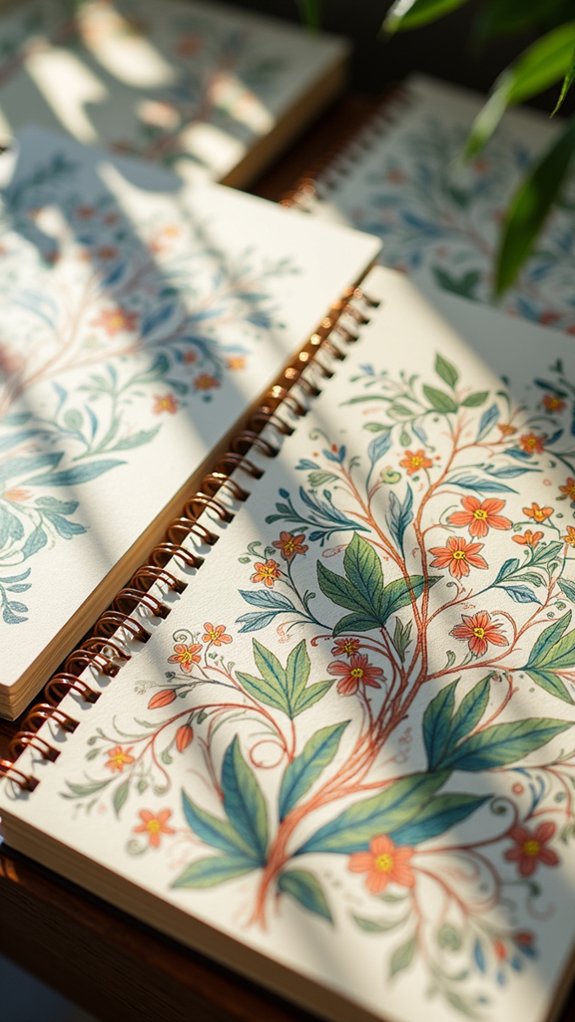
Switching gears from the wild world of photo montages, some artists get their inspiration straight from the great outdoors—and nothing says “nature lover” quite like a cover bursting with botanical illustrations.
These sketchbook covers are like window gardens, showing off delicate leaves, swirling vines, and bold petals. Using art materials like watercolors or colored pencils, creators can bring plants to life on the page. For extra texture, some even make a collage from pressed flowers or leaves—talk about a three-dimensional surprise!
Here are four ways to make your botanical illustration cover stand out:
- Draw favorite flowers or quirky plants in vibrant hues.
- Mix in seasonal leaves for a changing mood.
- Experiment with a collage using real botanicals.
- Use unique art materials for added detail and flair.
Celestial and Starry Night Design
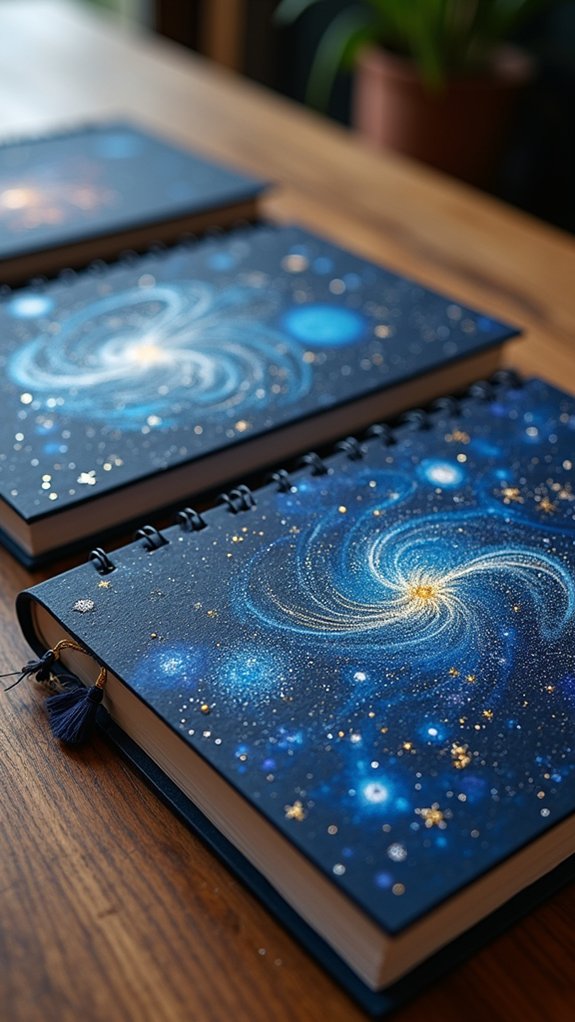
Celestial and starry night designs truly light up a sketchbook cover, and picking just the right cosmic color palette can make those stars almost twinkle.
Mixing in textures like metallic paint or even a sprinkle of glitter brings a hands-on vibe that’s impossible to ignore—who can resist a cover that shimmers?
With bold and inspiring star pattern motifs, artists get the perfect chance to create covers that are both magical and totally unique, maybe even out of this world.
Cosmic Color Palette Choices
Starry nights have a way of making everything feel magical, and that magic totally comes alive when choosing colors for a celestial sketchbook cover.
The right cosmic color palette can make your sketchbook look like it’s straight out of a dream—think deep midnight blues, rich purples, and shiny golds. These tones set the stage for all kinds of celestial motifs.
Want to make your design pop? Add some super-bright whites, silvers, or even sparkly mixed media techniques for extra flair!
Let’s break down some eye-catching ways to use cosmic color palettes for sketchbook covers:
- Combine blues and purples for a galaxy vibe.
- Add metallic gold or silver for shimmer.
- Use bright accents to highlight titles.
- Include favorite stars and planets as fun motifs.
Mixed Media Texture Ideas
There’s something seriously awesome about turning a plain sketchbook into a galaxy-inspired masterpiece using mixed media. When it comes to celestial and starry night designs, mixed media is like magic.
Picture metallic paints shimmering like a comet streak or textured fabrics that make your fingers want to explore every inch. Adding collage elements—think silver foil moons or ripped blue paper nebulas—gives a wild, otherworldly vibe.
Layering on translucent papers, embroidery threads for stitched stars, or even dabs of glitter cranks up that starry sky feeling. Watercolors and acrylics come together to swirl and blend, mimicking glowing galaxies.
Creative artists use contrasting colors to help titles pop. It’s all about cramming personality and celestial charm onto one amazing cover.
Inspiring Star Pattern Motifs
Magic happens when star patterns burst to life on a sketchbook cover. There’s just something enchanting about starry night designs that can make even the most ordinary drawing pad feel special.
Celestial imagery—think glittering constellations, shimmering moons, and pops of gold and silver—brings a sense of wonder with every glance. Artists love using mixed media techniques, like watercolor washes and acrylic splatters, to capture the swirling beauty of the night sky.
Want some ideas to try?
- Paint bold, contrasting stars with metallic pens to make titles pop.
- Use layered watercolor and salt for dreamy, cloudy space scenes.
- Sprinkle glitter or metallic foil onto wet paint for extra cosmic shine.
- Combine moons and planets for a galactic, super-unique vibe.
Acrylic Painted Artwork Cover
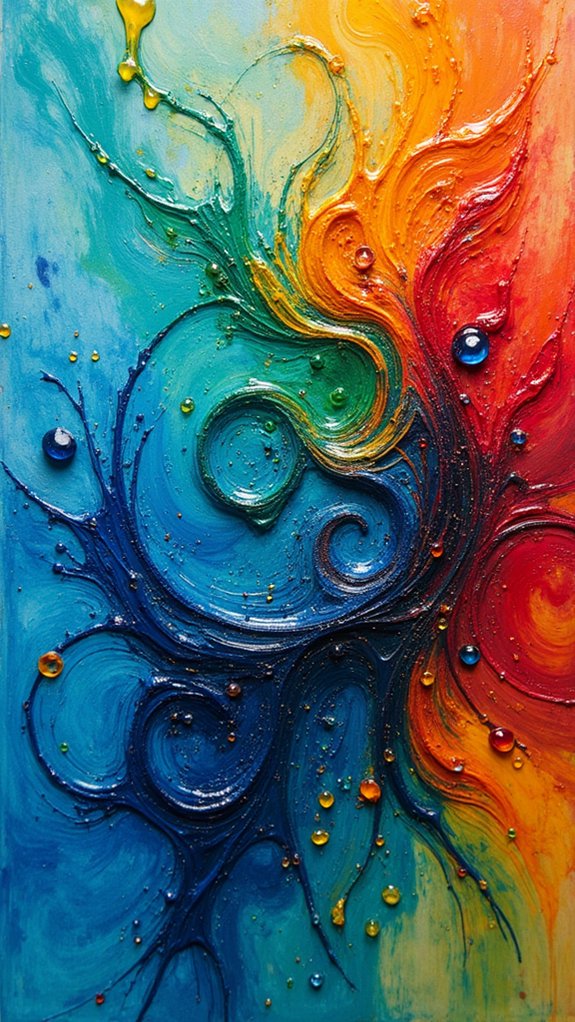
With acrylic painted artwork covers, artists can layer colors to create eye-popping depth that almost jumps off the sketchbook—think clouds floating in the sky or a superhero mid-action.
Of course, all that hard work needs protection, so sealing the cover helps keep the vibrant colors safe from scratches, spills, and the dangerous depths of a backpack.
Mixing art with a little bit of science, this process makes every cover both eye-catching and tough, ready for any creative adventure.
Layering Color for Depth
Although some people might just slap color onto a sketchbook cover and call it a day, artists looking for serious wow-factor know that layering colors with acrylic paint can totally transform a boring surface into something epic.
It’s not just about piling on paint—layering brings out depth and makes each detail pop! With a little creativity, even mixed media pieces can become the star of your cover design.
Here’s how artists make their covers stand out like pros:
- Experiment with transparent and opaque layers for a three-dimensional vibe.
- Use contrasting colors to highlight important areas or the sketchbook title—bam! Instant focus.
- Try glazing techniques for extra richness and color complexity.
- Add mixed media like fabric or paper for texture that you can actually feel.
Hello, masterpiece!
Sealing for Durability
After pouring heart and soul into painting a sketchbook cover, nobody wants to see all that hard work get wrecked by rain, greasy hands, or a rogue backpack zipper!
Seriously, who knew backpacks could be such villains? To keep that cover looking awesome, a good sealant is a must. When the acrylic paint is dry, a clear acrylic sealant or varnish creates a shield that boosts color and keeps everything safe from moisture, scratches, and even sunlight.
For serious durability, build up with multiple thin coats, being patient and letting each one dry. Spray sealants work great—they go on smooth and won’t smudge the paint.
Later, just wipe down the sealed cover with a damp cloth, and your masterpiece stays protected, vibrant, and ready for anything!
Bold Geometric Patterns
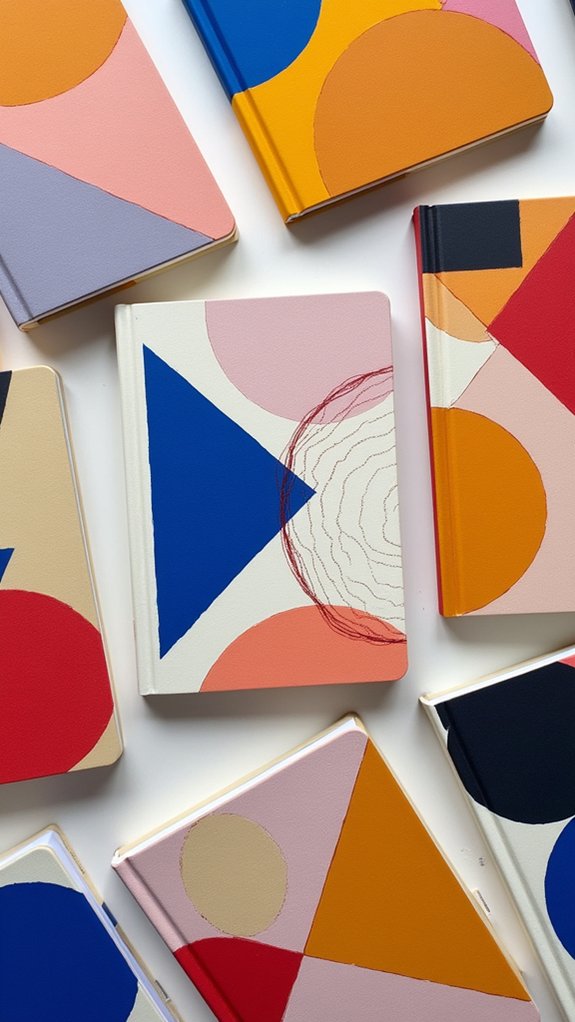
Bold geometric patterns are like the superheroes of sketchbook covers—they jump right out and grab your attention with powerful shapes and wild color combos.
These patterns use strong lines, sharp corners, and bold circles to create a punchy visual appeal that’s impossible to ignore. With so many ways to play around, artists can mix different geometric designs, try out fun collage styles, or layer up textures for something a little extra.
Ready for a new cover adventure? Here are four ideas to supercharge your next sketchbook:
- Combine triangles, squares, and circles for a modern twist.
- Layer different papers and paints to build a textured collage.
- Use contrasting colors to make your cover title pop.
- Match geometric designs with seasonal themes, like snowflakes or spring flowers.
Washi Tape Decorative Layout
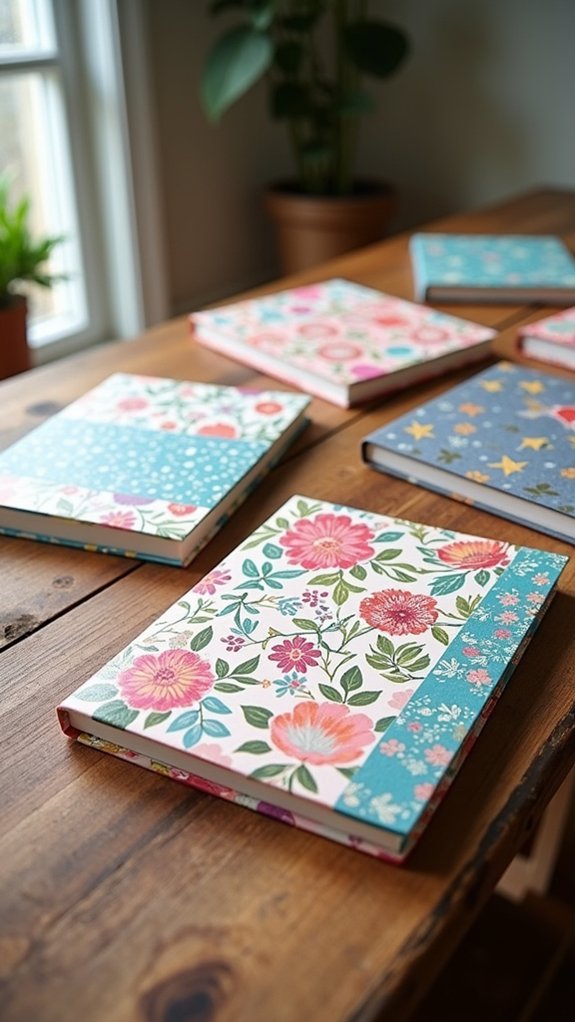
Washi tape is like magic for sketchbook covers—you get to pick bright, bold patterns, and the choices honestly feel endless.
Try layering different tapes to make your design pop, but be ready for a little trial and error to find out what sticks and what peels.
For a cover that lasts, artists often press the tape down firmly or add a clear sealant, so all those amazing stripes and shapes stay put even through backpack chaos.
Choosing Colorful Washi Patterns
How can something as simple as patterned tape turn a plain sketchbook cover into a work of art? It all starts with choosing washi tape in colorful patterns that grab attention and spark creativity.
Picking the right tape isn’t just about what looks pretty—it’s about mixing colors and designs for amazing design ideas that make your cover pop. Bold stripes, cute animals, shimmering metallics—washi tape has it all.
And if you change your mind? No problem—just peel and stick again. Here’s how to make your selection count:
- Look for washi tape that shows off bold, contrasting colors.
- Mix different colorful patterns for extra flair and personality.
- Try tapes in theme sets, like florals or galaxies, for a story-like look.
- Consider how the washi tape pairs with stickers or your own hand-lettering.
Layering for Visual Interest
Once there’s a pile of colorful washi tape ready to go, things can get even more interesting—because just sticking it down in straight lines is only the beginning. Layering is where the magic really happens. By stacking washi tape in overlapping bands, crisscrosses, or even wild zigzags, anyone can create a design bursting with energy and personality. Want more? Try mixing in bits of patterned paper or even stickers for a mixed media look. Artists often use contrasting colors so that certain words, doodles, or titles totally pop. The cool part? Washi tape is forgiving—move things around without panic! Here’s a table showing how different layering combos can change up a cover’s vibe:
| Tape Color | Layering Style | Mixed Media Element |
|---|---|---|
| Bright Neon | Zigzag | Stickers |
| Pastel Stripes | Overlap | Fabric Scraps |
| Metallic Gold | Crisscross | Patterned Paper |
| Black & White | Random Patch | Stamps |
| Floral Prints | Diagonal Bands | Buttons |
Securing Tape for Durability
When it comes to boosting durability and adding seriously cool decorative elements to a sketchbook cover, washi tape is a total game-changer. This clever, colorful tape comes in loads of patterns and widths, letting artists customize their covers and protect them from everyday wear and tear.
Applying washi tape is simple—and if you change your mind, just peel it off without ruining the cover!
Want more ideas for using washi tape for both function and style? Check out these tips:
- Reinforce the edges and spine with layers of washi tape for extra durability.
- Mix and match patterns to create bold borders or stripes that stand out.
- Overlap tape with stickers or your own doodles for a burst of creativity.
- Change up your design whenever inspiration strikes—no damage done!
Doodle and Sticker Explosion
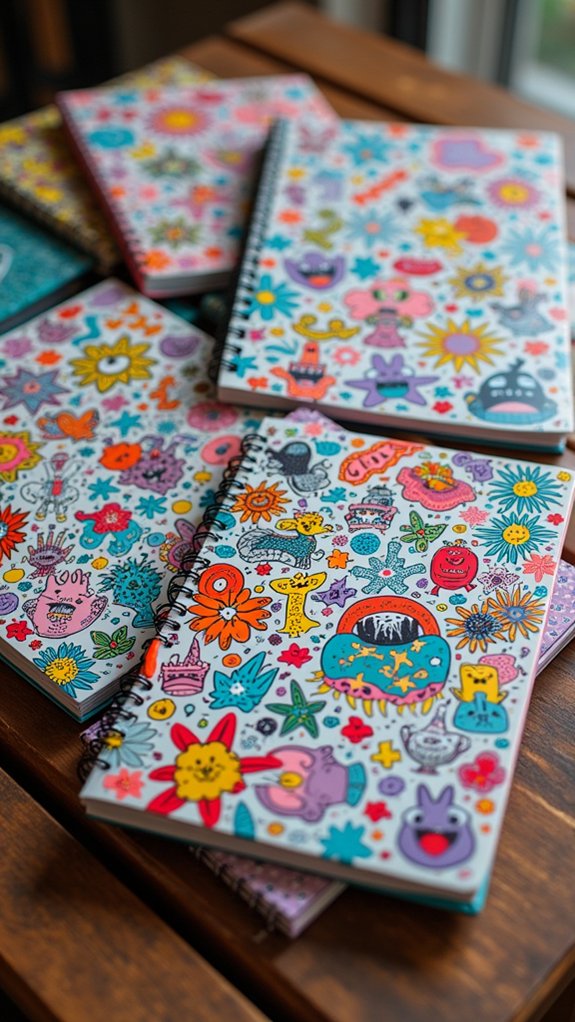
Doodle and sticker explosion covers practically shout creativity from across the room. They’re like a party for your sketchbook, where every inch is filled with wild, energetic design.
Artists plunge into their collections of stickers—sometimes trading with friends or hunting for the weirdest, coolest ones—and layer them alongside their own doodles. These doodles don’t have to be fancy; silly faces, squiggly lines, or even random patterns add so much personality.
Mixing stickers and doodle art lets each artist tell a wild, colorful story on their cover. There’s no “right” way to do it, just the fun of experimenting with design choices and layering.
Plus, these covers stand out in any pile—no chance of grabbing the wrong book by mistake!
Chalkboard-Style Cover With Gel Pen
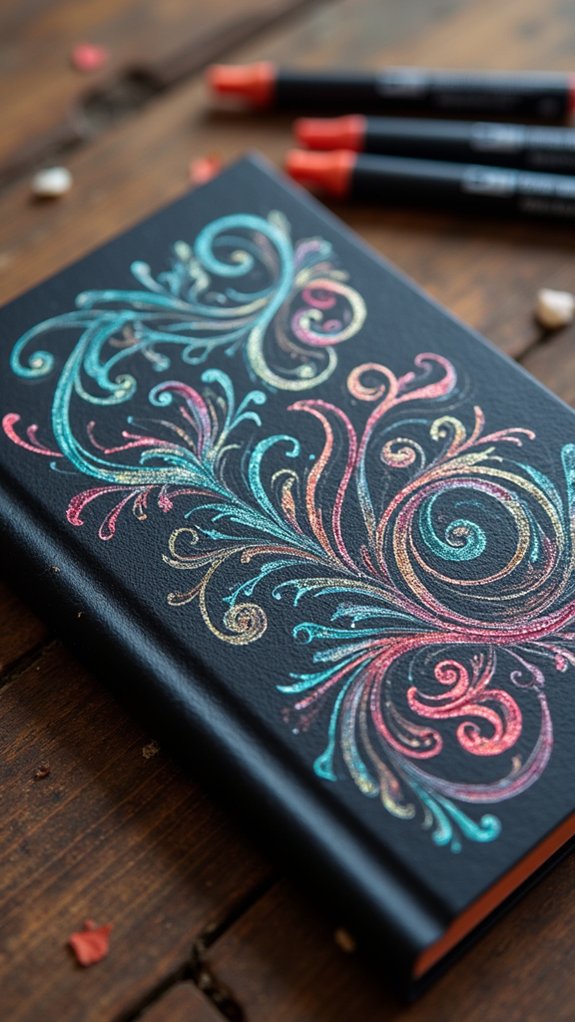
A blank, black cover can turn into a total showstopper with the chalkboard-style sketchbook. With just a sheet of black cardstock and a handful of bright gel pens, ordinary sketchbooks get an instant upgrade.
Imagine whipping out a personalized chalkboard-style cover, letting everyone see your drawing ideas come to life—right on the front! The best part? Each design is unique, making every sketchbook a creative statement.
Here are four ways to amp up your next cover project:
- Use white or metallic gel pens for vivid, popping artwork or fun hand-lettering.
- Add ribbons, washi tape, or stickers for extra flair and texture.
- Switch up your drawing ideas whenever inspiration hits—these covers are super interactive!
- Surprise friends with custom covers as unforgettable, personal gifts.
Vintage Ephemera Collage
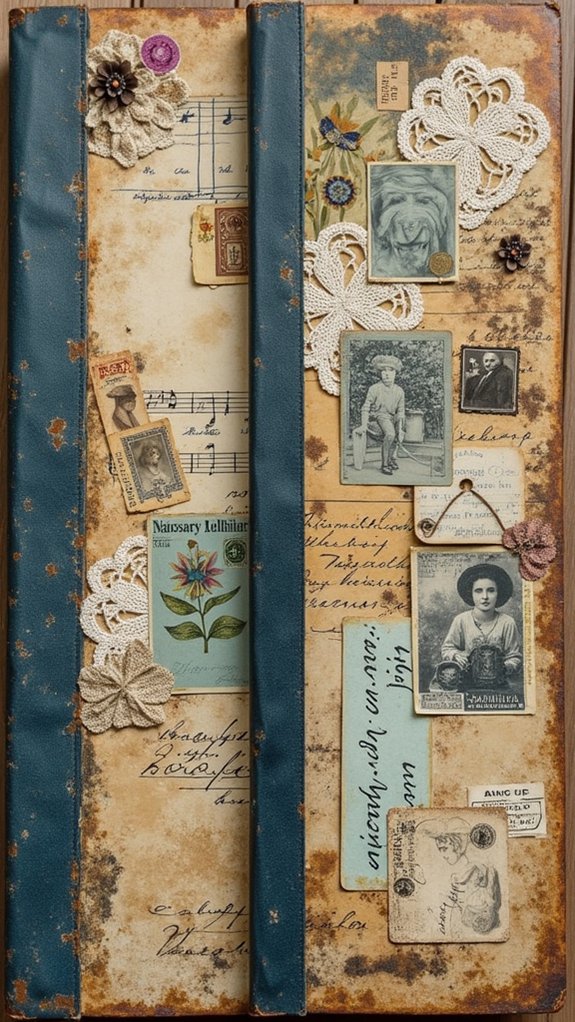
Vintage ephemera collage starts with the excitement of finding cool old stuff—think faded train tickets, quirky postcards, or wild old ads—each one holding its own secret story.
Artists layer these pieces using different glues and tricks to add depth, mixing rough papers with smooth surfaces and clashing patterns for a cover that’s bursting with personality.
Watching all these textures and colors come together can feel like putting together the world’s most interesting puzzle, and no two covers ever look the same.
Sourcing Unique Vintage Materials
An old ticket stub with crinkled edges or a postcard covered in faded handwriting can totally transform an ordinary sketchbook cover into something special.
When it comes to creating a collage with vintage ephemera, finding the right unique materials is everything—it’s a treasure hunt! There’s excitement in the search, and you never know what you’ll discover.
Adding real pieces of the past to your sketchbook doesn’t just look cool—it tells a story and helps the planet, too, by giving old things new life.
Here’s where to look for vintage ephemera:
- Thrift stores: Dig through bins for old photos, tickets, and books.
- Flea markets: Hunt for postcards and vintage ads.
- Online marketplaces: Try Etsy for one-of-a-kind collections.
- Family attic: Ask relatives for forgotten paper treasures!
Layering Techniques for Depth
Stacks of old postcards, yellowed book pages, and black-and-white photos can turn a plain sketchbook cover into pure magic—seriously, it’s like building a tiny time machine. When artists use layering techniques with vintage ephemera, they create covers that feel deep and packed with stories. Mixing collage elements like lace, fabric, and even washi tape brings out texture you can actually feel. Overlapping bits and pieces isn’t just fun; it draws your eye all over the cover, so you never get bored.
| Vintage layers | Tactile extras | Artistic tricks |
|---|---|---|
| Postcards | Lace | Paint washes |
| Book pages | Fabric | Ink details |
| Photographs | Washi tape | Color contrasts |
Layering techniques make each sketchbook cover totally unique—like your own masterpiece, right in your hands.
Combining Textures and Patterns
Even though it might sound a little wild, throwing together different textures and patterns is actually where the real magic happens in a vintage ephemera collage.
There’s just something about mixing old postcards, scraps of fabric, and colorful patterns that turns an ordinary sketchbook cover into an awesome work of art. The textures you pick tell a story—each piece has a little bit of history and personality.
Layering them, plus adding your own doodles or paint, makes your collage pop and totally unique.
Here are four cool ways to combine textures and patterns for sketchbook covers:
- Add lace or metallic elements for extra depth and a cool shimmer.
- Use hand-painted details over your collage for a personal touch.
- Mix color schemes from vintage paper for emotional impact.
- Include tactile materials to make your art inviting to touch!
Nature-Inspired Landscape Art
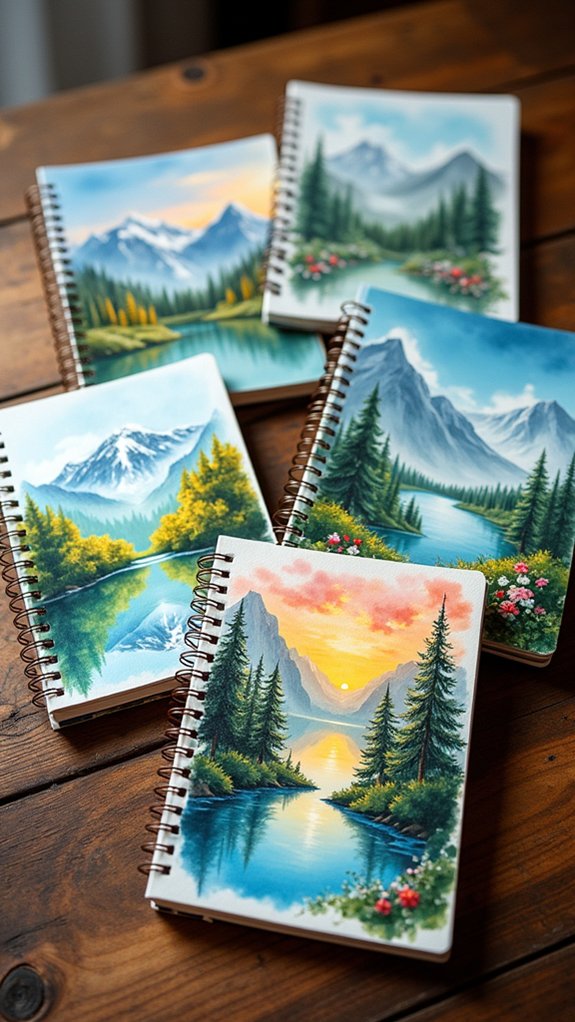
Imagine opening a sketchbook and discovering a world where mountains, forests, and sparkling lakes leap right off the cover—that’s the magic of nature-inspired scenery art.
These covers often capture the spirit of the wild, using terrain art that blends bright colors, swirling skies, and even cool collage techniques for extra flair. Some artists love mixing watercolors for dreamy sunsets or layering acrylic for the look of real, rugged cliffs.
Collage can pull in bits of magazine, dried leaves, or painted paper to replicate fields or rivers—talk about going green! Changes in the seasons inspire fresh perspectives too, swapping fiery autumn leaves for icy blue lakes.
Add animals or hidden birds, and suddenly, your sketchbook whispers secret stories from the great outdoors.
Expressive Self-Portrait Design
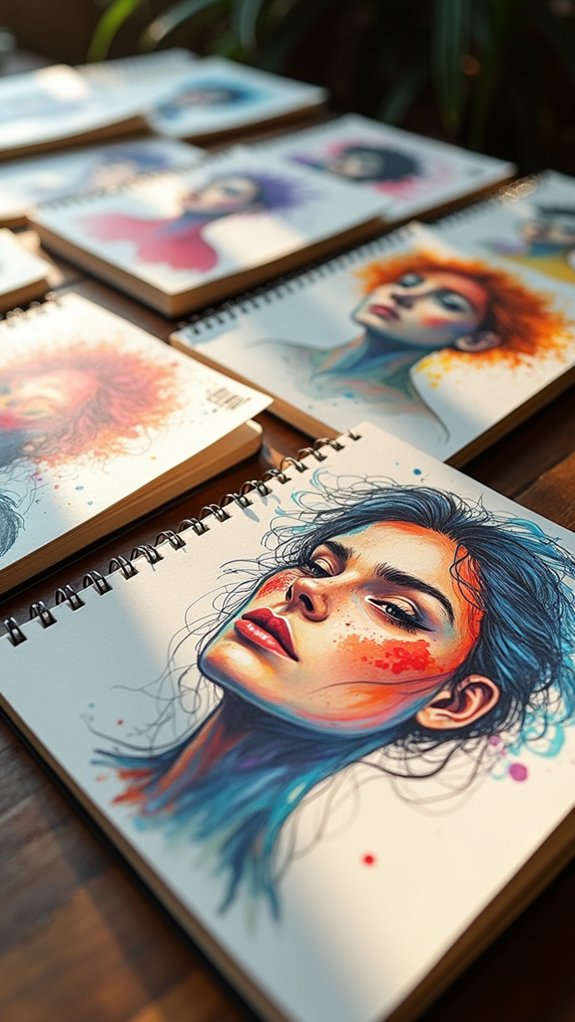
Expressive self-portrait covers let artists show who they really are, using symbols and personal images that can be as quirky or meaningful as they want—think sunglasses made from pizza slices if that’s your vibe.
Mixing collage and drawing brings portraits to life with unexpected textures, colors, and a style that’s totally your own. With each new layer or detail, students experiment with storytelling and creativity, turning a simple face into a kind of secret code about themselves (plus, it’s way more fun than a plain old selfie).
Symbolism Through Personal Imagery
Personal imagery holds a special power when it comes to self-portraits, turning a simple drawing into something packed with meaning and emotion.
When artists add personal items—like their favorite hat, pet, or even a unique hairstyle—it’s like giving their art a secret code, only they fully understand.
Everyone’s collage of memories and emotions is different, making each design one-of-a-kind.
Symbolic elements, such as meaningful objects or favorite colors, can speak volumes about who the artist is inside.
If you want some inspiration, here are four creative ideas:
- Add a collage of tickets, drawings, or photos to represent your hobbies.
- Show personal imagery like family heirlooms or favorite pets in your self-portraits.
- Use symbolic colors that express different moods.
- Incorporate mini doodles of dreams or future goals!
Exploring Mixed Media Portraits
A whole world of creativity opens up when artists plunge into mixed media portraits. Imagine a sketchbook cover that’s so much more than just paper and pencil—it’s a mashup of paints, fabrics, and even a quirky photo or two.
By mixing and matching collage materials, a self-portrait can feel totally alive, practically jumping off the page! Those who love to discover art might try adding bold colors or rough textures, making every facial feature pop.
The real fun? Grabbing anything—from old concert tickets to a favorite T-shirt scrap—to give personal meaning and hidden stories. Each piece sends a message, reflecting the artist’s own personality and wild imagination.
Mixed media portraits make covers exciting and full of life, every single time.
Y2K Nostalgia Aesthetics
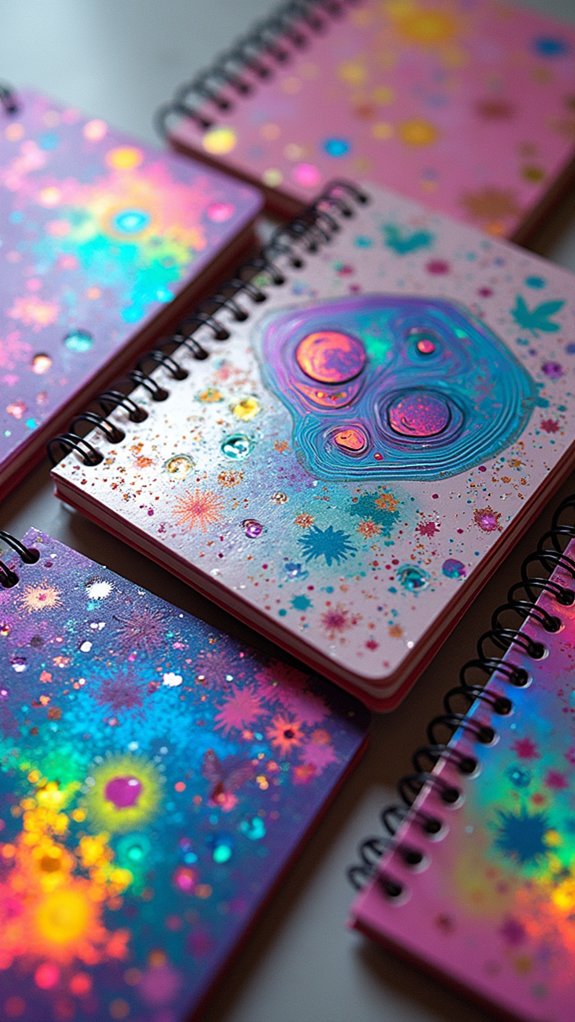
Even though the early 2000s might seem like ancient history to some, Y2K nostalgia is totally making a comeback, and sketchbook covers are catching that throwback fever.
Bright neon colors, metallic vibes, and cheerful smiley faces are popping up everywhere. If you love wild design ideas for your sketchbook’s front cover, this style lets you go full-out with fun and creativity—seriously, it’s like digital meets arts-and-crafts.
Many young artists use collage techniques to mash up holographic papers, magazine clippings, and chunky internet-style fonts. Here are some cool Y2K sketchbook cover ideas to try:
- Glue on foil stars, glitter, and bubble letters for maximum sparkle.
- Mix retro tech doodles with playful patterns.
- Use collage to layer magazine snapshots and stickers.
- Experiment with pixel art or pastel gradients.
Marine Life and Jellyfish Motifs
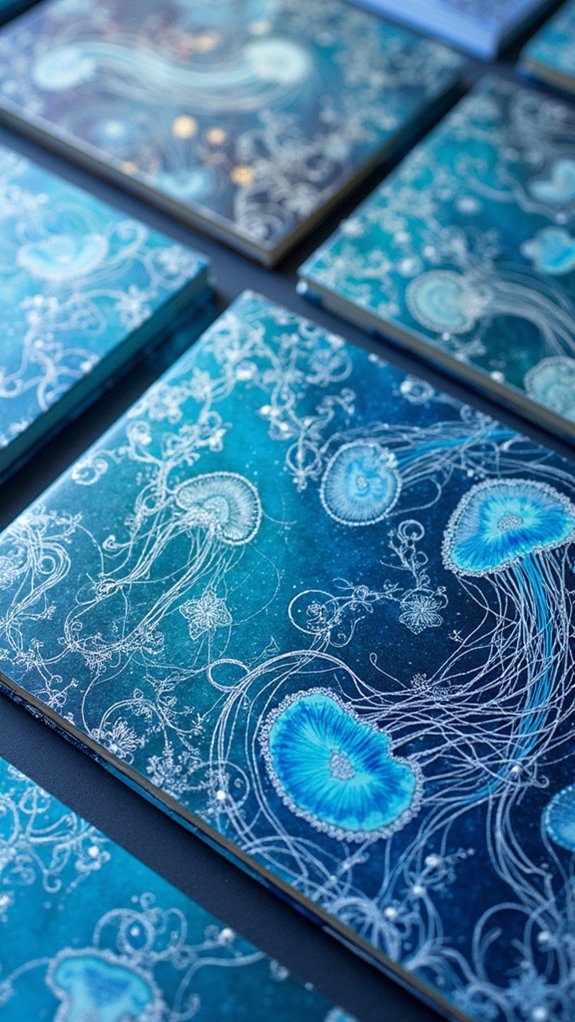
Once all the Y2K sparkle and neon chaos has been explored, there’s a whole other world waiting beneath the waves—literally.
Marine life and jellyfish motifs bring a whole new type of magic to a sketchbook design. Imagine a book front swirling with luminous blues and purples, wavy tentacles, and mysterious patterns, drawing you in like a tide you can’t escape.
The front page could feature watercolor jellyfish floating in a glowing sea—maybe even with a bit of fabric stitched in for a fun, touchable surprise.
These page ideas are perfect for artists who love experimenting with mixed media and crave something unique. Art challenges in the community also love this theme, so you’ll always have inspiration and company beneath the surface!
Metallic Foil Accents
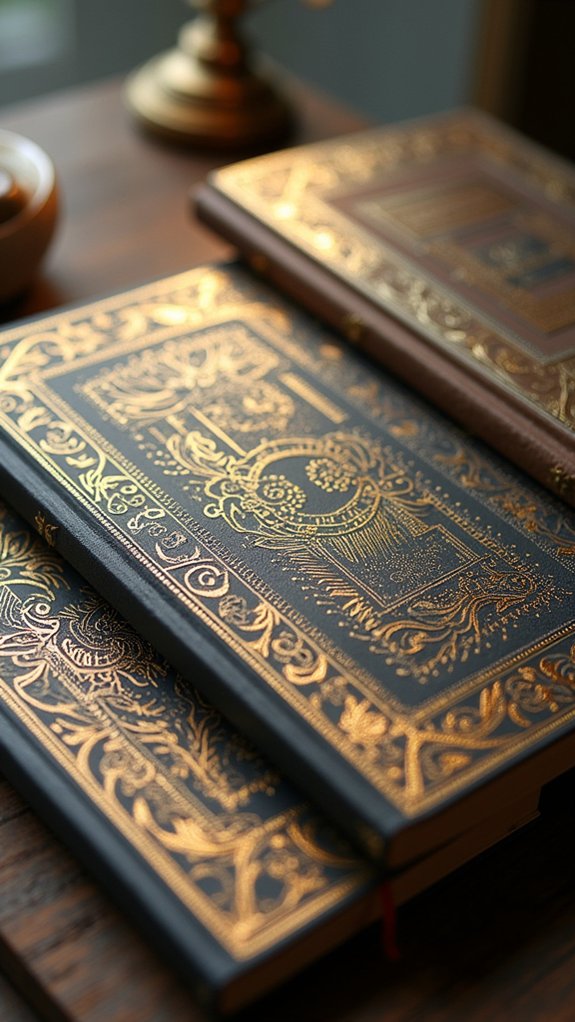
Metallic foil accents can make any sketchbook cover look a little more magical, but picking the right foil color is key—gold, silver, or even rainbow foil can totally change the vibe.
Different methods, like using transfer foil sheets or shiny pens, let artists add dazzling details, and sometimes even a cool 3D effect.
For those feeling extra bold, mixing metallic foil with paint, markers, or even stickers creates a stand-out cover that nobody else in class will have—unless your little brother gets inspired and copies you!
Choosing Foil Colors
Why do some sketchbook covers just seem to pop off the shelf and demand attention? It’s all in the foil color! The color you pick for those metallic accents can totally change how a book looks on the front Page, setting the mood even before you draw a single doodle.
Want your cover to sparkle in the spotlight? Here are a few smart tips:
- Gold foil screams luxury and warmth, while silver might be perfect for a cool, modern vibe.
- Bright foil colors (think fuchsia or teal) crank up the playful factor, making your sketchbook fun at first glance.
- Earthy tones like bronze or copper add instant sophistication to the front Page.
- Mix a dark matte cover with a pop of metallic foil for drama that’ll stop anyone flipping through.
Application Techniques Explained
Diving into the world of metallic foil accents feels a bit like opening a treasure chest—suddenly, everything on a sketchbook cover looks way more dazzling.
The main foil application methods begin with a transfer foil technique, where a special adhesive is used to stick shiny metallic foil onto the cover. Outlining your design with gold or silver pens before adding foil makes shapes and letters pop even more.
For a layering techniques overview, artists often experiment by adding multiple foil layers or combining them with colored backgrounds for a cool 3D effect.
Want to catch everyone’s eye? Try mixing bold metallic color combinations with contrasting tones. Even simple geometric patterns or just your name in foil look instantly cooler, almost as if your sketchbook’s wearing jewelry.
Combining Foil With Mixed Media
So, foil accents already make sketchbook covers sparkle, but what happens when they get mixed up with other materials?
Suddenly, you get mind-blowing sketchbook covers that have more texture, shine, and personality than ever before. By using foil layering techniques, artists can create reflective surface effects that catch the light and catch everyone’s attention—kind of like a disco ball, but less tacky and way more artsy.
Mixing metallic foil with things like textured fabric, bold patterned paper, or even gold pens really shows off those mixed media contrasts.
- Add transfer foil in unexpected shapes for shiny surprises.
- Layer metallic foil with textured textile scraps for crazy depth.
- Use gold pens alongside foil for popping highlights.
- Mix minimal foil with different papers for instant classy vibes.
Abstract Pen and Ink Drawings
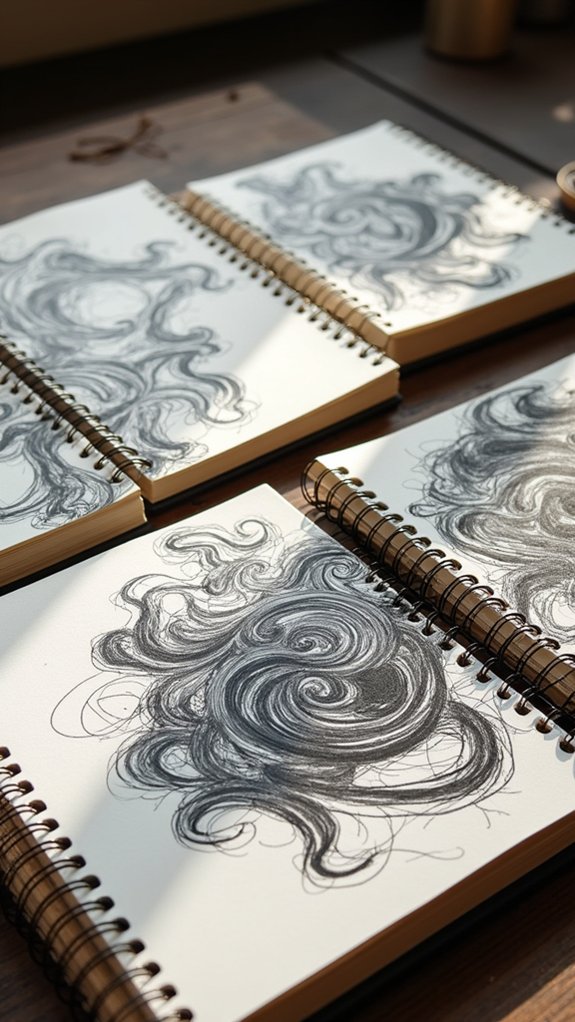
Swirls, zigzags, and wild shapes come alive when an artist grabs a pen and lets their imagination run wild. Abstract pen and ink drawings turn ordinary sketchbook covers into a playground for creativity.
By playing with line variation techniques—thick, thin, wobbly, or sharp—artists can create dramatic effects. The exploration of abstract expression encourages bold moves and unexpected twists, where half the fun is not knowing where the next line will end up.
With texture contrast methods like cross-hatching or stippling, a simple drawing suddenly pops off the page, catching both the eye and the fingertips. Some covers explode with wild patterns inspired by nature or geometric designs, while others whisper secrets through moody, swirling lines.
Each sketchbook becomes a one-of-a-kind piece.
Kraft Paper Customization
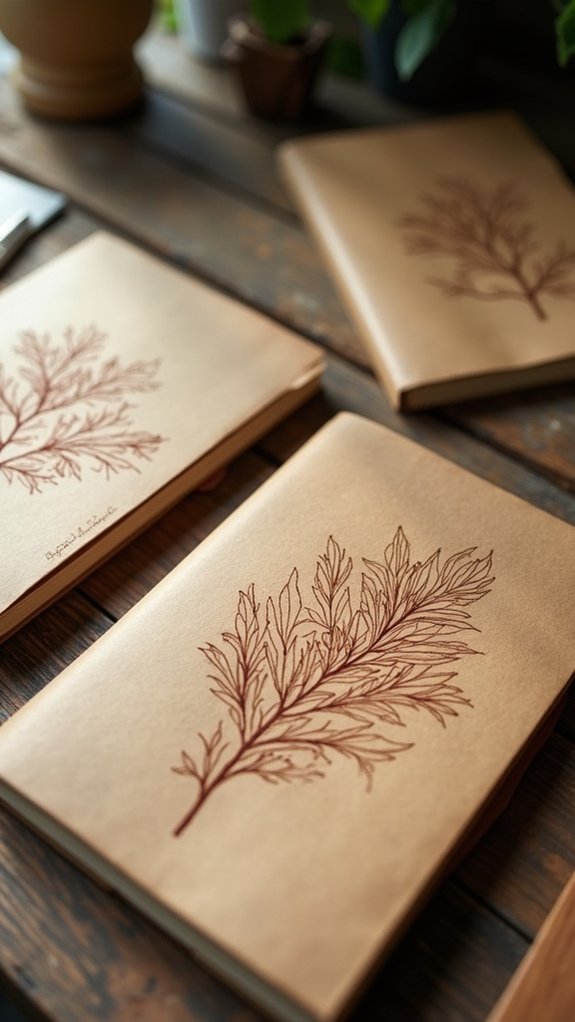
Kraft paper has a way of making any sketchbook feel like a secret treasure chest just waiting to be opened. The natural brown color and sturdy texture give off cool eco friendly vibes and make every cover a chance for sketchbook personalization.
You can customize it a million ways—collage, stickers, washi-tape, or even some quick hand-lettering with metallic pens if you want that “classy-cool” look. Plus, kraft paper durability means it won’t fall apart after just one doodle session.
Check out these creative ways to amp up your next sketchbook:
- Try embroidery right into the cover for a crafty look.
- Use decoupage with old mags for extra pop!
- Add shiny foil accents for an elegant twist.
- Make mini portable covers for art on the go.
Holiday and Mistletoe Decoration
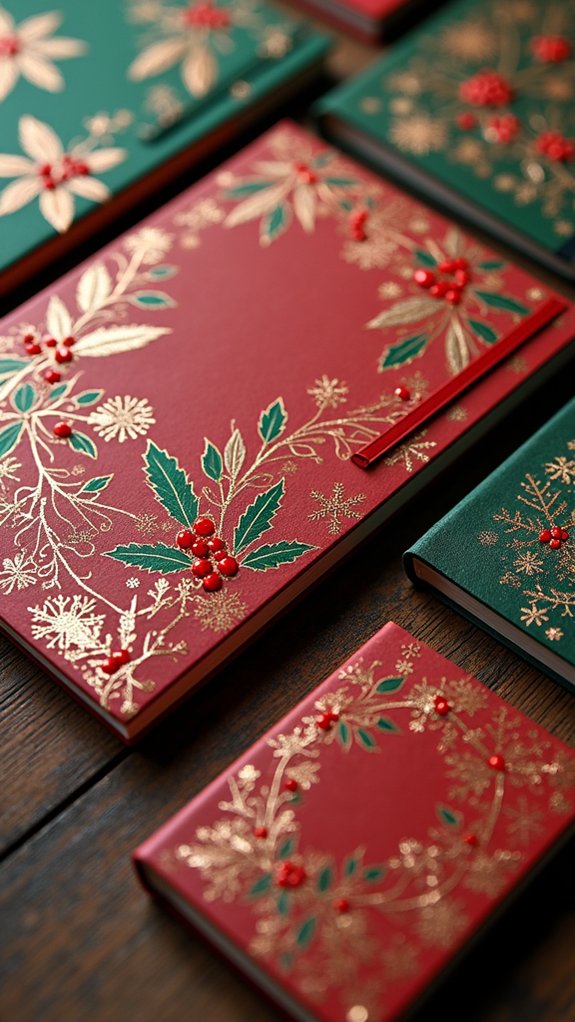
Imagine this: after decking out a sketchbook with all the cool kraft paper tricks, the urge hits to make something even more special for winter break—and that’s where holiday and mistletoe decorations come in. Suddenly, it’s not just any sketchbook but a cozy winter masterpiece.
Mistletoe patterns? Yes, please. They’re the perfect touch, especially when paired with festive color palettes: deep reds, evergreen, and snowy white.
Artists love using mixed media, like layering watercolor snowflakes or acrylic holly leaves, adding dimension and fun textures. Ribbons, fancy stickers, and hand-painted designs can really pop. Plus, adding holiday symbolism—think sparkly ornaments or candy canes—lights up the entire cover.
Seasonal art challenges make it even more exciting, inspiring everyone to join in the festive creativity.
Frequently Asked Questions
What Protective Sealants Work Best for DIY Sketchbook Covers?
When choosing protective sealants for DIY sketchbook covers, many recommend water based sealants for easy cleanup, spray varnishes for even application, or acrylic finishes for durability. Each option helps preserve cover designs against moisture and wear.
Can I Design a Reusable Sketchbook Cover for Multiple Notebooks?
Designing a reusable sketchbook cover for multiple notebooks is feasible using flexible reusable materials, such as fabric or leather. Employing adaptable design techniques allows for interchangeable sizes, while customizable cover aesthetics guarantee personal style is maintained across different notebooks.
How Do I Fix Mistakes on My Finished Cover Design?
When addressing errors on a finished cover, individuals should explore mistake correction techniques such as careful erasing, layering new materials, or using paint. Effective cover design adjustments and artistic revision strategies can refine and improve the overall result.
What Are Eco-Friendly Materials for Customizing Sketchbook Covers?
When considering eco-friendly materials for customizing sketchbook covers, options include recycled fabrics, biodegradable alternatives like cork or kraft paper, and sustainable printing using soy-based inks. These choices minimize environmental impact while maintaining functionality and aesthetic appeal.
How Can I Create a Durable, Travel-Friendly Sketchbook Cover?
To create a durable, travel-friendly sketchbook cover, material selection tips recommend sturdy fabrics or leather, while reinforced stitching techniques enhance longevity. Portable design ideas include magnetic closures, elastic bands, and slim profiles to maximize ease of transport and everyday usability.
Conclusion
Choosing the right sketchbook cover isn’t just about looks, it’s about showing who you are. Whether you’re wild for watercolor, into moody pen and ink, or like to glue stuff down just because, there’s a cover idea here to match your style. Don’t be afraid to experiment—mistakes might become your favorite part. So grab some supplies, maybe make a mess, and let your next cover be as awesome (and weird) as you are.

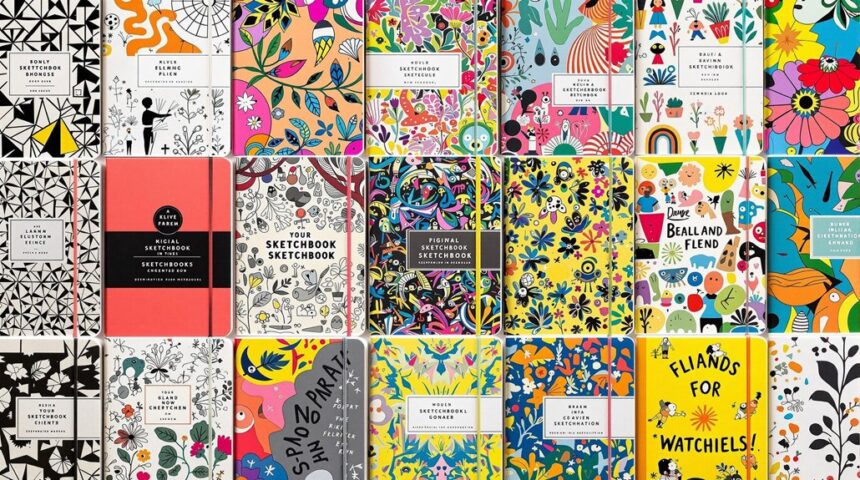
Leave a Reply